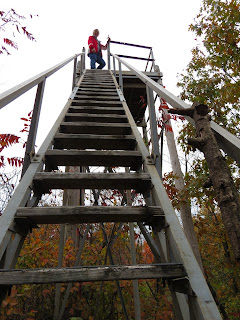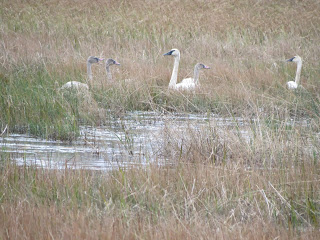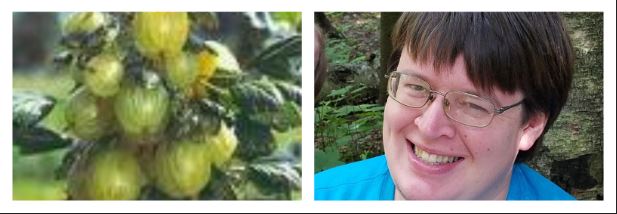A while back I was looking at a map and noticed the Sandhill State Wildlife Area, which is just to the west of Babcock, Wisconsin. We go right by there now and then, when we're heading to points west, but I had never really been aware of it. So I began to look into what it is and what is there. I learned that it is a 9,150 acre nature reserve operated by the state. Actually, it adjoins a couple of other nature reserves; the Wood County Wildlife Area and the Meadow Valley Wildlife Area, for a total of over 90,000 acres of nature reserves managed by the state.
So I began to look into what is there and what might be worth seeing and discovered it has a fair amount of interesting stuff. Because it is a nature reserve there is not a lot of development there, like a national, state, county, or local park may have. But it does have what's called the Trumpeter Trail - a 14 mile trail with several "stations" along the way with things to stop and see. My initial thought was to take our bikes and ride the trail but then I learned that it is a dirt road. I have ridden on dirt roads but I find I have to go slower to keep from loosing my balance and spilling. The loose dirt and sand have a way of shifting and causing problems so I tend to stay off dirt roads unless they're pretty hard packed. Plus the thought of having to ride out 14 miles and then back over the 14 miles would turn it into a record breaking ride for me. So we ended up deciding to drive the trail, which turned out to be just fine. Oh, and the trail also turned out to be a loop so we wouldn't have had to make a return trip that doubled the ride. I also learned that there are three observation towers along the trail. So several weeks ago we picked a date and determined to make the trip. The goal became to travel the trail and climb each tower.
The date picked was yesterday, Saturday. We targeted arriving at the main entrance around 10:00 or 11:00 am. We actually arrived just before noon. Not bad, considering the way errands and chores have a way of piling up on Saturday, since its really the only day of the week for so many errands and chores that are too big for an evening after work.
At the time we picked the day for the trip we were just picking a date far enough out to be open - we weren't really thinking about the weather or time of year. It was a bit of serendipity that it turned out to be just a little passed "peak" for the fall colors. A week sooner and they might have been a little better but as it was the leaves and colors were still incredible. Fall is an amazingly beautiful time of year.
The main entrance is at the southeast corner of the reserve, just a couple miles west of Babcock. The reserve is gated and has a high fence, high enough to keep deer from being able to jump over.
They have a little registration station where you sign in. It reminded me of some of the mountain parks I've seen where you sign in with enough identifying information that they can find you if they have to come looking for you. Those kinds of places also have you sign back out when you leave so they can account for everyone. Sandhill did not have us sign out. But we had to open and close a gate to get both in and out again when we left.
Because it is so large, Sandhill has a variety of landscapes so driving the trail took us through a couple different types of flora containing a wide variety of fauna. As we drove away from the main entrance the area was marsh and wetlands, with areas of jack pine, maple, and oak forestation. The area was once covered by the Glacial Lake Wisconsin that at one time covered large areas of the state.
Along the trail there are a total of 17 stations, most of which are marked. Then there was a handout you could pick up at the gate that gave a little bit of information about each station. Some were more interesting than others, and not all were very well marked along the trail.
The first two were really just informational, about Sandhill, and watching for wildlife more than anything else.
Pretty quick the area opened up and became a big marsh area, a wetland. Lots of tall water grass, cat-tails, lily pads, and the like.
I was hoping to see to see a few whooping cranes - we do see those around from time to time. But on this trip we did not. Not even any sandhill crane, for which the area is named. Ah, well. There were plenty of other things to see.
It was probably getting too cool and late in the season for much in the way of wildlife to be out. Still, it was incredibly beautiful.
Some of the stuff growing up out of the water, reflecting on the water, reminded me of abstract sculpture in one area.
We began to see milkweed that had opened up, letting its cotton like insides come out to release seeds.
Lots of seeds sitting on puffs of cotton.
Lots of bugs on some of the plants as well. These rusty browns and tans of fall are singularly amazing colors.
A little farther along the road we began to see cat-tails. Some looking pretty intact still.
Others beginning to disintegrate and scatter.
Others fully "exploded" and misshapen.
After a few miles we began to get back into more forested area.
We stopped at what's called the Swamp Buck Hiking Trial, a spur that goes off from the road for a 3.5 mile walking trail than runs along one of the marshes.
We parked the car and hiked out the trail but only 40 or 50 yards or so. But there was some really amazing things. The dampness of all the marshes creates a wet climate that encourages fungus, mushrooms, and algae growth all over everything.
I found myself wishing I knew the plants better. There is such a wide variety of things growing everywhere you looked, big and small.
I would love to have known what kind of plant this was that was growing on the trail. It reminded me of cockle burs before they dry and harden. I know that's not what this is, it isn't mean enough looking. We saw it all over the place.
Stopping for a "selfie" along the trail.
Stop #6 along the trail was the first tower. It was off the road maybe 80 to 100 yards.
It wasn't a very tall tower, either. Only about 20 steps, making it the shortest of the three towers in the reserve.
But from the top you could see some of the small herd of buffalo that live in the reserve. They keep the herd at about 15-20 animals. We saw eight from the tower.
Shaggy, dark looking critters. They were just grazing, you had to watch them for a little while to see that they were slowly moving through the prairie grass.
We stayed and watched them for a while and then decided to move on.
As we moved away from the buffalo the area began to be forested with trees and bushes more like we're accustom to seeing around the area. And the colors got really nice. Reds ...
Yellows ...
More yellows ...
Oranges ...
An incredible variety of colors on the deciduous trees, mixed here and there with lingering greens from trees that were slow making the transition, or coniferous pines and other evergreens that hang on to their leaves or needles all winter.
And the variety of oaks that go rusty red and then brown but don't drop all their leaves, keeping some all winter long and letting them drop in the spring.
After a few more miles we came to the second tower, the North Bluff tower. This was at stop #11. This tower sits atop a hill so its the most difficult tower of the three.
At the parking area the trail begins deceptively easy looking, although with all the leaves down it was a little difficult to be certain this actually was the trial.
But we had found it, it wasn't very long before in the distance we could see some stone steps so we knew we were on the right way.
We got to the steps and they began to rise, not too steep at first.
But climbing ever up and up. Covered with leaves.
Leaves and pine needles. It was easy to see why the guide said the trail could be challenging if wet, because of the leaves and stone. Could get slippery.
Being stone steps they weren't always evenly spaced like you find in your house. Some were a little taller than normal, some were more narrow than you're used to. Brombeere was kind enough to find me a walking stick, which helped a lot.
Once we got to the steps they went on almost all the rest of the way to the top. Even with the stone steps, though, there were so many leaves the trail was sometimes hard to see.
Finally we reached the top of the steps. In something like 250 to 300 yards we had climbed 200 feet. No wonder the guide described the trail "The trail is not recommended for people with heart conditions or those who must avoid strenuous exercise."
I forgot to count steps coming up the side of the hill, but there were 36 steps up to the top of the tower. Not too bad, as observation towers go around the state.
And we both made it!
The view at the top was well worth the climb! It seemed like you could see forever.
I have now been up several towers around the state of Wisconsin and seen some pretty nice views but I think this one is the best so far!
Maybe the colors had something to do with it.
I like to think, though, that the unspoiled view had more to do with it.
In any direction you looked there was very little evidence of people. Here and there you caught a glimpse of the dirt road, way far away in the distance you could make out an occasional building. Otherwise, a clear view of wilderness.
A little windy but not bad at all, poking way up in the sky like that. And an overcast day so it wasn't unpleasantly warm. It was a very nice day for a hike in the woods.
There are two kinds of endangered butterflies native to the area, the Karner Blue butterfly and the Dusky Elfin butterfly. We didn't see much in the way of butterflies and I'm not sure we'd know recognized either of these had we seen any. We did, however see some birds that flew differently than most birds we're familiar with. They flit from place to place so much that at first we thought they were butterflies - they were small. Then, when we realized they were birds we thought maybe they might have been hummingbirds. But it soon became apparent they were not humming birds, either. Just a little bird with odd flight mannerisms.
After a while it was time to head back down. Back down the tower steps, back down the stone steps, back down the hillside.
Saw this little fellow at one stop we made to take pictures. Brombeere hopped out of the car to take her pictures and as she was getting back in she saw she had stepped over this guy. Not the little ribbon snake we saw at a different park a couple of weeks ago. This seemed more like some kind of brown snake. It was tiny, probably only a few inches long. The picture makes it look bigger than it really was.
A few more miles down the road we came to the last tower, the Marsh Observation tower. This was at stop #14. There was a short hike to this tower, as well, but only about a third of a mile.
The hike included a small bridge over a little canal.
But after a while we came to the tower, the tallest of the three.
It was taller, but only by a few steps. So up we went.
Another gorgeous view. You can't see them in this picture, but way out there, just to the right of center, were a couple of swans swimming around on the water.
We took in the view for a while and then it was back down to the trail. By this time it was getting late in the early afternoon and we needed to get back home.
On our way out we came across another marshy area, this one had a beaver's house out in the pond. I was kind of surprised. Every beaver hutch I'd ever seen before has been in a damned river. That's what beavers are famous for. We used to see them on a regular basis on the way to my grandma's house in Wyoming.
In that same pond we saw a number of swans.
Even a family of swans, two adults with three youngsters, still with the grey coloring, just losing their grey downy coloring. I thought they must have been born late in the season. They're not geese, but all the young geese I see all the time at home have all lost their down and are into their full feathered plumage at this point.
Anyway, at this point we had been in the reserve nearly three hours, having a blast taking in the colors and sights, stopping all over the place to take pictures or just marvel at the scenery. We decided we definitely want to go back, but at a different time of year. Probably in the spring, after everything has finished budding out and is in full bloom. I think that would be another real pretty time of year. And who knows - maybe we'll do it on bikes next time, if it hasn't been raining too much. You know how spring rains can be. We'll have to see.
4 months ago





































































2 comments:
Oh, that looks lovely! I must spend more time browsing maps, and finding cool places. You find some of the best stuff.
If you want to learn more plants, there are a bunch of Facebook groups for identifying plants and mushrooms and so on. And for real study, Botany in a Day is a great book, though I'm still chuckling at the title, a year after I bought it. But it's got a great system for learning plants by learning families, and then fitting plants into the families as you find them. Pretty cool stuff. I didn't used to know the name of *anything* when I went out, but it's lots of fun to start to recognize some of the plants when we're out and about.
Looks like another fun adventure. Yay!
Post a Comment